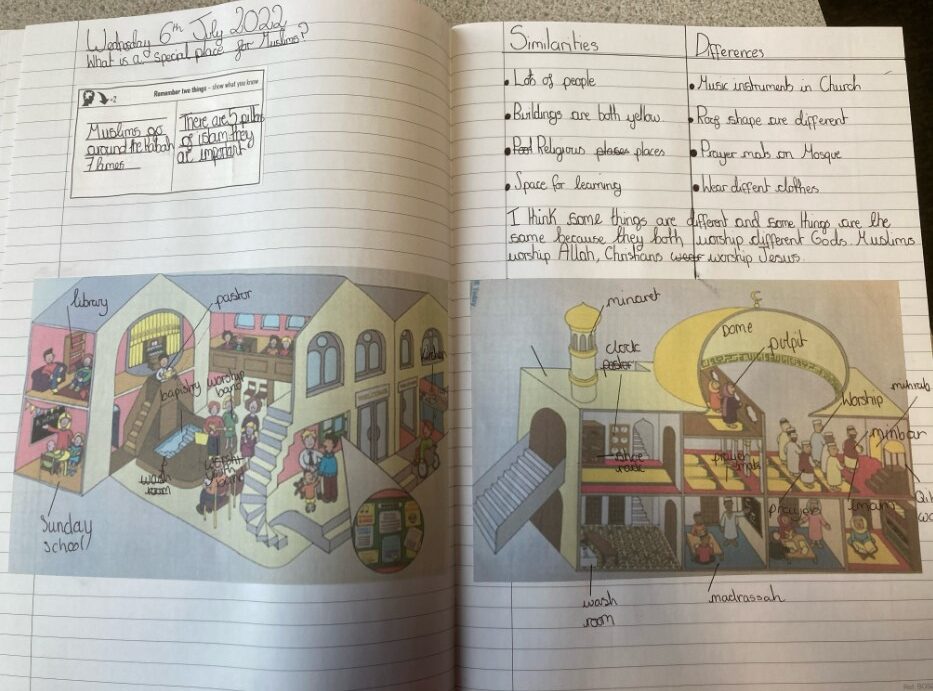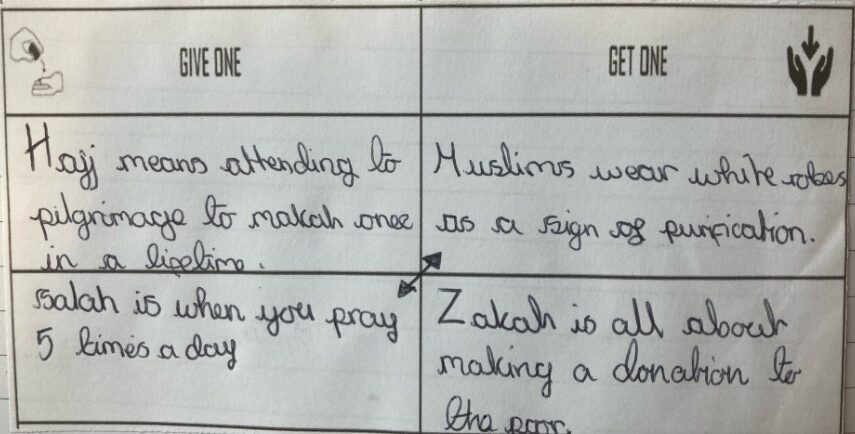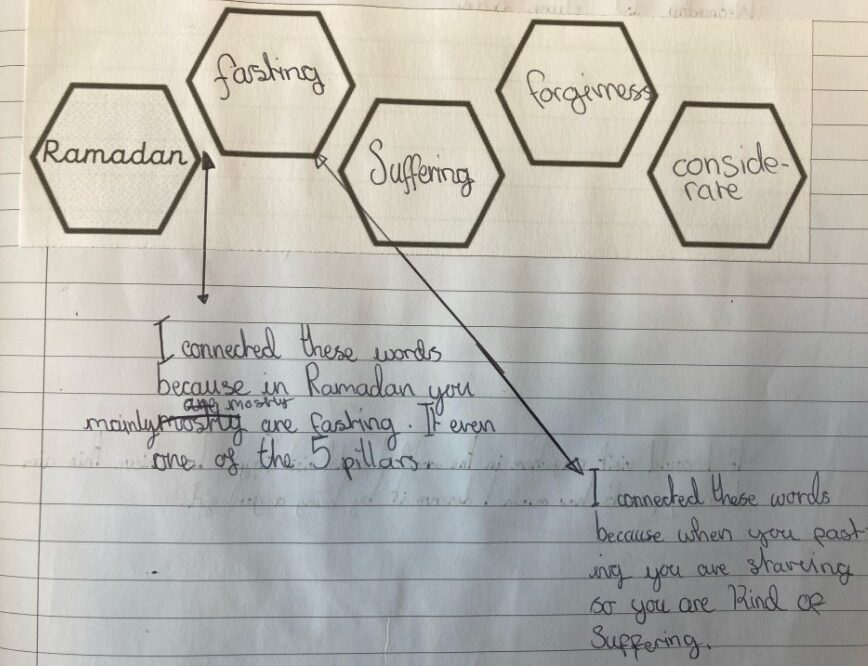Religious Education (RE) at John Scurr
Our Curriculum Drivers are to promote resilience, develop communication and ensure all pupils have access to all learning possibilities both in and out of the classroom. Our Curriculum Intent is for pupils to know more, do more and learn more.
‘RE is like an iceberg. As you unpack ideas, you come to understand deeper meaning’.
Pupil
Organisation of Knowledge
At John Scurr, we believe that a robust RE curriculum is central to pupils’ academic and personal development. The role that RE plays in instilling respect and empathy in our pupils is not undervalued, and it is vital to promoting social cohesion in our diverse society.
Religious education contributes dynamically to our children’s education by provoking challenging questions about meaning and purpose in life, beliefs about God, ultimate reality, issues of right and wrong and what it means to be human. In RE, pupils learn about and from religious and non-religious worldviews in local, national and global contexts, to discover, explore and consider different answers to these questions.
At John Scurr, we begin the year with all children taking part in our annual RE project – Making Connections through Right and Wrong. Each year group learns about what different religions believe and teach about right and wrong. The project is driven by the quote from the late MP Jo Cox – ‘we have more in common than that which divides us’. By exploring links and commonalities between religions, children really get to the root of this quote, and across their time at John Scurr they develop a good understanding of how we are united as humans within and across religions and worldviews.
In week 3 of the Autumn term, all pupils visit a Place of Worship to give real world context to their learning from the classroom, and to allow them to further discover, explore and consider religions and world views.
From Week 5 of the Autumn term onwards, we follow the Tower Hamlets Agreed Syllabus, taking units of work from the syllabus and implementing them using the guiding principles of CUSP. The curriculum is designed cumulatively so that knowledge and skills are built upon year by year, with pupils’ understanding of the concepts ‘belief’, ‘belonging’ and ‘worship’ being deepened and developed as they move throughout their primary school journey. Frequent retrieval practice and spaced retrieval practice ensure knowledge is committed to long term memory, allowing for the working memory to make connections when new knowledge is introduced. Pupils at John Scurr learn about religions and non-religious worldviews by being exposed to authentic sources, such as holy books, artefacts and religious and non-religious leaders and believers. They interrogate surveys and carry out interviews. This gives them an insight into the discipline of RE and how theologians, philosophers and sociologists come to know what they know. Disciplinary knowledge is built on in every year group so that pupils become experts in the subject by the time they leave primary school.

What Do We Teach
| Below you will see the areas of study covered by each year group, including the key question from the Making Connections through Right and Wrong project, the place of worship visited, and the areas of learning covered by the Tower Hamlets Agreed Syllabus. The Tower Hamlets Agreed Syllabus is structured around 3 strands: Believing (B) Expressing (E) Living (L) Nursery: Whole school project: Emotions and Feelings Place of worship visit:Mosque Nursery children then learn about different religions by celebrating a range of religious and non-religious festivals throughout the year. Reception: Whole school projects: Emotions and feelings Places of worship: Church Tower Hamlets Agreed Syllabus Which stories are special and why? (B) Which people are special and why? (B) Which places are special and why? (L) Which times are special and why? (L) Where do we belong? (E) What is special about our world and why? (E) Year 1: Whole school project: What do different religions teach about gratitude? Place of worship visit: Synagogue Tower Hamlets Agreed Syllabus: Who is Christian and what do they believe? (B) What makes some places sacred? (E) What does it mean to belong to a faith community? (L) Year 2: Whole school project: What do different religions teach about compassion? Place of worship visit: Synagogue Tower Hamlets Agreed Syllabus: Who is Jewish and what do they believe? (B) How and why do we celebrate special and sacred times? (E) How should we care for others and the world and why does it matter? (L) Year 3: Whole school project: If you do something wrong, can it be put right? Place of worship visit: Hindu temple Tower Hamlets Agreed Syllabus: What does it mean to be a Hindu in Britain today? (L) What do different people believe about God? (B) Why do people pray? (E) Year 4: Whole school project: In the journey of life, what makes things better and what makes things worse? Place of worship visit: Church (contemporary) Tower Hamlets Agreed Syllabus: How do people from religious and non-religious communities celebrate key festivals? (E) Why is Jesus inspiring to some people? (B) What can we learn from religions about deciding what is right and wrong? (L) Year 5: Whole school project: What do religious people decide how to solve dilemmas? Place of worship visit: Regents Park Mosque Tower Hamlets Agreed Syllabus: What does it mean to be a Muslim in Britain today? (L) If God is everywhere, why go to a place of worship? (E) What do religious and non-religious worldviews teach about caring for the Earth? (L) Year 6: Whole school project: Is it possible to have a truly peaceful world? Place of worship visit: St Paul’s Cathedral Tower Hamlets Agreed Syllabus: What difference does it make to believe in Ahimsa (harmlessness), Grace (the generosity of God), and Ummah (community)? (L) What can be done to reduce racism? What can we learn from religious and non-religious worldviews? (E) What do religions say to us when life gets hard? (B) |
How do pupils learn?
Our RE curriculum is implemented using the guiding principles of CUSP. Pupils frequently practise retrieval to allow them to commit new learning to long term memory. At the start of every lesson, they will revisit prior learning to ensure it is not forgotten. This prior learning is then built upon so that the learning sequence is cumulative

Pupils present their work from each lesson on a double page spread to reduce split attention effect and to ensure that the cognitive load is manageable. All pupils have the opportunity to think hard during RE lessons by using:
All pupils have the opportunity to think hard during RE lessons by using:
- double page spreads to take the focus off organisation
- word path frameworks to chunk up information and make it more digestible
- word connection exercises to drive connections within and between vocabulary and concepts

Each lesson is driven by a key question which pupils engage with and interrogate. This allows them to develop the understanding and skills to appreciate and appraise various responses to these questions. Pupils discuss their responses to these questions using their oracy skills, making use of their hand signals and discussion roles to agree with, build upon and challenge ideas. Teachers also use the principles of P4C when presenting and discussing big questions, so that pupils can use philosophical dialogue and enquiry in their discussions.
How do we know what children have learned
- Questioning
- Pupil Book Study
- Talking to teachers
- Low stakes ‘dropin’ observations
- Retreival practice
- Feedback and marking